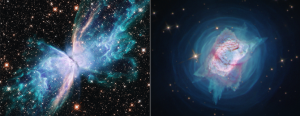
Most telescopes aren’t survey telescopes, but every facility was built with a certain purpose in mind. One of the oft-forgotten purposes of the Hubble Space Telescope (HST) was to understand the planetary nebulae. Now, more than thirty years after its launch, HST is still struggling to fulfill this goal.
When stars approach the ends of their lives, they shed their outer layers. This material drifts away, creating a myriad of complex shapes that appear as a round or roundish blob in most Earth-based telescopes. With Hubble, these blobs get resolved into complex shockwaves and tendrils of material, and even back in 1997, it was apparent that these nebulae don’t have a one-size-fits-all explanation of their structures.
Today, using the third edition of the Wide Field Camera, astronomers have shown that the level of details and nuance seen in these objects only goes up as the observations get better. Using the full observational range of Hubble, from the ultraviolet all the way out to the infrared, researchers have looked at two previously studied nebulae, NGC 6304 or the Butterfly Nebula, and NGC 7027 which is the Jewel Bug Nebula. The two bizarrely shaped nebulae are thought to be the result of binary systems where the orbital plane of the two systems pinched in the waist of the expanding material to create an hourglass. The different colors in these images each trace different atoms and temperature ranges. The images’ high resolutions allow individual shockwaves to be studied, revealing in the process that both systems underwent rapid fluctuations.
In fact, the researchers can even measure some differences between these latest images, and those captured by Hubble early in its lifetime.
Ultimately, researchers hope to sort the details behind how these structures form. It’s nice to say these are binary systems, but that lacks specifics. There are currently two competing theories for their formation: either two stars orbit one another and interact such that they create a disk, which in turn generates the outflowing material, or the two stars merge, and the merged object has outflowing jets. According to team member Bruce Balick: The hypothesis of merging stars seems the best and simplest explanation for the features seen in the most active and symmetric planetary nebulas. It’s a powerful unifying concept, so far without rival. While astronomers continue to study this problem, we can continue to expect more amazing imagery. I have to admit it almost makes me hope that it takes them a long time and a lot more nebulae to find all the answers they want.
More Information
Hubble Space Telescope press release (ESA)
“First Results from a Panchromatic HST/WFC3 Imaging Study of the Young, Rapidly Evolving Planetary Nebulae NGC 7027 and NGC 6302,” Joel H. Kastner et al., 2020 June 15, Galaxies




 Join the Crew!
Join the Crew!
 Escape Velocity Space News
Escape Velocity Space News
0 Comments